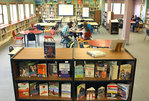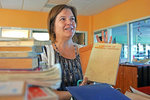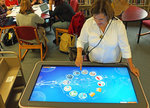Thanks to city and school district collaboration, Port Townsend students are seeing their libraries evolve to better prepare them for the 21st century.
“We’re really on a trajectory to bring …
This item is available in full to subscribers.
We have recently launched a new and improved website. To continue reading, you will need to either log into your subscriber account, or purchase a new subscription.
If you had an active account on our previous website, then you have an account here. Simply reset your password to regain access to your account.
If you did not have an account on our previous website, but are a current print subscriber, click here to set up your website account.
Otherwise, click here to view your options for subscribing.
* Having trouble? Call our circulation department at 360-385-2900, or email our support.
Please log in to continue |
|





Thanks to city and school district collaboration, Port Townsend students are seeing their libraries evolve to better prepare them for the 21st century.
“We’re really on a trajectory to bring our libraries from places that simply hold books to places that break down walls and serve as beacons of learning,” Port Townsend School District librarian Ann Healy-Raymond said of a more-than-five-year concerted effort to reinvent both school and public libraries for the benefit of the community and its students.
Planning began long before the Port Townsend City Council and school board adopted their most recent memorandum of agreement in May, which aims to foster a well-educated workforce and improve public access. It also encourages resource sharing, promotion of programs and collaboration to ensure young people and students have the skills and resources needed to succeed.
Port Townsend resident Kristina Mayer, a facilitator in the effort and chair of the Washington State School Board, said the district libraries have failed to keep pace with the times.
“We have not had a school librarian before last year that was actually advancing us,” Mayer said, adding that until Superintendent Dr. David Engle and Healy-Raymond came on board during the summer of 2013, school library leadership and innovation was lacking.
“We’ve already advanced a decade in a year in our way of thinking, the materials available, the vision, everything,” Mayer said. “It’s monumental.”
With the help of a $138,000 Paul Allen Foundation grant, Healy-Raymond and others have been able to take stock of district library collections and do a bit of weeding.
During the summer of 2013, University of Washington researchers shared what they found over two nights analyzing the combined collections of the district libraries and Port Townsend public library. While researchers found that the district libraries were comprised mostly of nonfiction, they also found “a surprising number ... were out of date and no longer relevant.”
While the mean publication year of books at the elementary and middle schools fell in the 1990s, that of the high school was 1983, with “a pronounced number of materials published in the 1960s and 1970s.
“On the shelf was ‘DOS for Dummies,’ and we’re not a historical library,” said Healy-Raymond. “I mean we have a history section, but we’re not a historical library. That was our most recent book on technology.”
The researchers combed through about 25 percent of the combined collection of the district and public libraries, recommending more than 30 percent be thrown out.
“Accuracy was a problem with some of our materials because of their age,” Mayer said. “I mean, you’ve books in here that show Africa divided in ways it hasn’t been for decades, and that’s not real helpful.”
Since that initial inventory, Healy-Raymond has worked with fellow school staff to both clean up the schools’ collections and reorganize each school’s library. First up was Blue Heron Middle School’s library, the benefits of which students began enjoying last school year. This year, high school students returned to an entirely reconfigured library of their own.
“I see students coming into the library a lot more often now,” said Healy-Raymond. “I see students feeling like they want to be in the library and like the materials are for them. I think it's a lot more friendly.”
With rows of shelving for books now removed, the high school library features more open spaces, tables geared toward group work and an abundance of laptops and Chromebooks available for check-out and usable anywhere thanks to the district’s recently-updated wireless Internet.
Much like the Jefferson County Public Library in Port Hadlock and Port Townsend Public Library, bookshelves are less cramped. Instead, some bookcases are given themes, such as health or maritime culture, and made to pull in potential readers like those in retail bookstores.
“The old library had banks of old Macs [computers] in front of the windows like boat anchors,” said Healy-Raymond. “So we got rid of those and brought in some old and refurbished laptops and students began to come in to the library to collaborate on schoolwork. It’s a whole change in what happens in the library. It’s a change in the culture. It’s become a place for students to work, research and to create and collaborate. It’s different than coming in and just consuming information.”
The Paul Allen Foundation grant has allowed the city library to purchase iPads for children while allowing the district to purchase Chromebooks as well as interactive technology such as an ActivTable and an ActivBoard from a company called Promethean.
Healy-Raymond has also begun compiling LibGuides, which are collections of digital resources on different topics found on the high school’s website. Port Townsend Public Library plans to link to those, as well.
The district has joined the public libraries' book catalogue through a company called Polaris as well as an e-book service through a company called Overdrive, streamlining login information to make it easier for students to move between the libraries.
“One of the barriers for adults and students are the many logins and passwords we have in our lives,” said Healy-Raymond, stressing the value of collaboration in making information more accessible.
Mayer said a major driver in improving students’ access to information and offering curated resources, such as Healy-Raymond’s LibGuides, is to help students meet the requirements of the Common Core State Standards (CCSS), which take full effect this school year.
“Common Core really requires a lot of different habits for kids – a lot more balance between fiction and nonfiction and our collections aren’t quite ready for that,” she said, also pointing out that state exams will soon be done online. “There’s an immense amount of pressure right now for us to get our kids online and using technology well. You don’t want kids to have technology get in the way of them answering questions on a state exam.”
With help of some 70 Chromebooks at Grant Street Elementary, Healy-Raymond said she has begun teaching third-graders about digital literacy and digital citizenship. She is also teaching such skills to fourth- and sixth-graders at Blue Heron.
“We’re just building up from the ground on what some of those research and technology skills should be,” she said.
Maker spaces, which encourage hands-on creation and experimentation rather than passive consumption of information, are also getting off the ground with help from public library staff and community members.
Last year, Chris O’Dell of Mobilisa began leading a computer programming club that met after school in the library. Toward the end of the year, a student’s idea to create a gaming maker space was approved and Sara Bonneville, the district’s business manager, has expressed an interest in leading it.
With guidance from the public library’s recently hired youth librarian Kit Ward-Crixell, robotics clubs are expanding and students are being introduced to Raspberry Pi single-board computers for more experimentation with programming and computer engineering.
“Kit, coming in with her expertise and this new technology has just catapulted us,” said Mayer. “For this community, we are moving at lightning speed all of a sudden.”
Ward-Crixell said giving students the time and resources to experiment with computer programing and engineering in a group setting is key to preparing them for the jobs of the future. She said by the year 2020, a projected 1 million computer science jobs will go unfilled due to a lack of qualified workers.
“So, at a time when computer science jobs are growing at twice the national average and they are one of the highest paying job fields, we are really failing our kids in preparing them for that,” she said. “It’s critical that they get those skills.”
Mayer agreed, adding that some 2,500 science, technology, engineering and mathematics jobs went unfilled last year in Washington state.
She said, “Part of the reason we’re doing these things is to get more kids to the libraries and show them that libraries aren’t just old books on musty shelves but that there are exciting things happening there, exciting things for the future.”